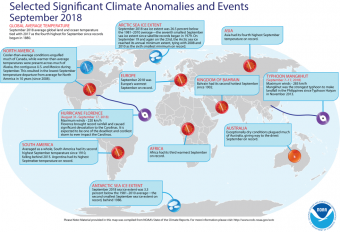After a summer of record-breaking heatwaves and devastating wildfires, 2018 is shaping up to be one of the planet’s hottest years in recorded history.
From January through September, the average global temperature was 1.39°F above the 20th century average of 57.5°F, making it the fourth warmest year-to-date on record, and only 0.43°F lower than the record-high set in 2016 for the same period, the National Oceanic and Atmospheric Administration ( NOAA) announced Wednesday. NOAA’s global temperature dataset record dates back to 1880.
NASA climate modeler Gavin Schmidt tweeted this week that 2018 was “almost guaranteed to be the 4th warmest year in the record.” The only years hotter? 2016, 2015, 2017, respectively.

This past September was also the fourth-hottest on record. “In fact, the 10 warmest September global land and ocean surface temperatures have occurred since 2003 with the last five Septembers (2014, 2015, 2016, 2017 and 2018) ranking as the five warmest on record,” the report noted.
Parts of the Atlantic and Indian Oceans, North America, South America, Europe, Africa and Asia observed record-warm temperatures during the month, NOAA found.
“Temperatures were at least 3.6 degrees F above average across southern South America, Alaska, the southwestern and eastern U.S., much of Europe, the Middle East and parts of Russia,” the report said.
Average sea-surface temperatures were also the fourth-highest on record in September and fourth-highest for the year to date.
Furthermore, sea ice coverage remained smaller than usual at the poles. NOAA said that the average Arctic sea ice coverage (extent) last month was 26.5 percent below the 1981-2010 average, the seventh-smallest extent for September on record.
At the same time, Antarctic sea ice extent was 3.3 percent below average, the second smallest for September ever recorded.
Source: Eco Watch


